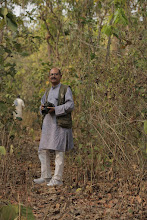She transformed MCP Mohandas
As a teenager boy Mohandas, married to teenager girl Kastur, was what
today's feminists would call a typical MCP - a tyrant who believed in
subjugating his wife. He asserted his conjugal rights and was so possessive of
his wife that he told her to seek his permission every time she wanted to visit
a temple. Kastur defies the diktat and visits the temple. When confronted by
Mohandas, she curtly replies: "No one can stop me from visiting the temple
of God."
Mohandas Karamchand Gandhi, thus, learned from his wife Kasturba the
first lesson of Satyagraha and non-violent civil disobedience, a state craft
which made him a Mahatma.
Though the young barrister Gandhi got the credit for the success of his
Satygraha against the oppressive all-white government of South Africa, it was
Kasturba who courted arrest by defying the law which considered as illegal all
marriages that were solemnized according to Hindu or Muslim rituals. She, not
Gandhi was the first Satyagrahi. When in jail she was denied fruits and
vegetables, she undertook an indefinite fast compelling General Smutts to
concede her request for a vegetarian meal.
Gandhi was a libidinous young man who had fathered four children.
Realizing that he would not be able to pursue a life dedicated to the cause of
the people without taking a vow of celebacy, Gandhi made Kastur to take a
pledge with him. She gave her consent willingly.
Since then and till the day Kasturba died in Aga Khan Palace, Pune on
February 22, 1944, the husband and wife called each other by the names Bapu and
Ba (father and mother).
This and other such aspects of Kasturba's fiercely independent
personality and yet complete devotion to her husband's goals and ideals have
been depicted in a two-hour play on her written by the 88-year-old Narayan
Desai whose four-volume biography of Gandhiji 'My life is my Message" has
won wide acclaim.
This is Narayan Desai's fist attempt at writing a full-length play for
any professional theatre group. He has been ably helped in this maiden venture
by eminent Gujarati theatre director-cum-actor Aditi Desai whose influence on
the playwright's pen comes out brilliantly in the dialogues of various
actors.
The inaugural show of the play was staged on February 22 at the
auditorium of Gujarat Vidyapith, a university founded by Mahatma Gandhi in
1920.
The Hindi version of this Gujarati play is getting ready and is planned
to be staged outside Gujarat shortly.







